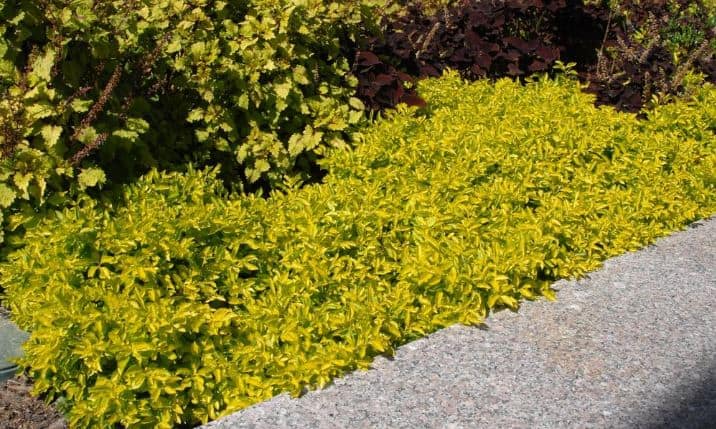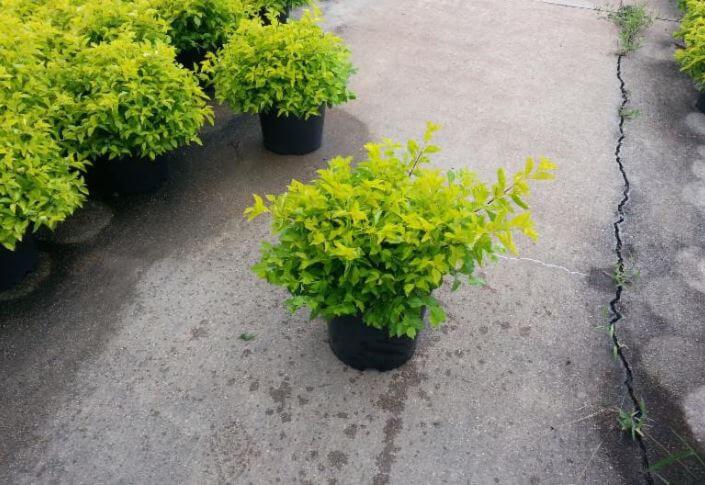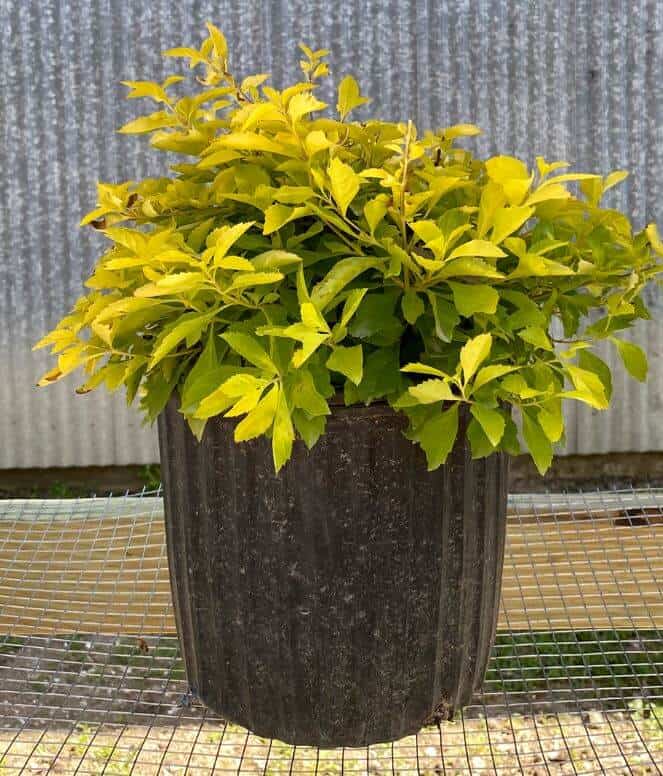Last Updated on September 9, 2023 by a Friendly Gardener
Beautiful chains of blue blooms and stunning gold-yellow leaves—the Duranta species of flowering shrubs are a visual spectacle to behold in any space. Of these, the Cuban gold plant is a standout, beloved for its ornamental aesthetic.
With gorgeous all-gold leaves and berries, this somewhat uncommon and highly prized flowering shrub is an excellent annual border and container plant.
Not only do the Cuban gold’s showy fruit, flowers, and foliage elevate your indoor/outdoor garden’s aesthetic appeal but the plant itself is a pollinator magnet, attracting hummingbirds and butterflies—a fairyland garden indeed!
If you’d like to add a Cuban gold plant to your garden, read on to know everything about the plant and growing it.
About the Cuban Gold Plant

The Cuban gold plant is a flowering shrub from the Verbenaceae family and the 21-species-strong Duranta genus. Referred to as Duranta erecta in scientific circles, along with the rest of the species in the genus, the Cuban gold plant is native to the tropical regions of the Caribbean, South America, and Mexico.
A common feature in ornament subtropical and tropical gardens across the world, the Cuban gold plant is also referred to as skyflower, duranta Cuban gold plant, pigeon berry, golden dewdrop (for their golden berries), and even just duranta.
There are plenty of duranta cultivars available, the most popular being Variegata, Aussie Gold, Aurea, and Sapphire Showers. Some of these cultivars feature solid gold leaves like the Cuban gold, while yet others feature variegated leaves. Typically, though, the species features beautiful, glossy green leaves.
Duranta plants, including the Cuban gold, are not generally given to flowering—something that their lovely foliage makes up for—but some varieties can bloom in brilliantly blue five-petaled forms, often featuring a white edge, in the right hardiness zones. The maximum blooms occur in the growing season—spring and summer.
In the tropical wild and in the right hardiness zones, where there is no exposure to frost and freezing-cold temperatures, these tropical beauties can reach heights and widths of 12 feet or higher.
In gardens, where they are commonly grown as summer-season annuals, you can only expect growth of three feet, and that, too, during the growing season alone.
The leaves of the Cuban gold plant are around two to three inches long, with a short spike at each leaf’s base.
It’s extremely important to note that while songbirds enjoy the fruits of this plant, the unripe berries and leaves of Cuban gold plants are highly toxic to both humans and pets, with reports of death in the latter category. Therefore, if you have pets or small children in the house, keep the plant well away from their reach.
Plant Snapshot

- Common Name: Duranta
- Botanical Name: Duranta erecta/ Duranta repens
- Other Names: Skyflower, golden dewdrop, pigeon berry, duranta, Cuban gold plant
- Type of Plant: Annual, broadleaf, tropical, evergreen shrub
- USDA Hardiness Zones: 10 and 11
- Maximum Height: When cultivated as an annual, between one and three feet; in the wild, and in conducive zones where it is cultivated as a perennial, twelve feet and higher
- Maximum Width: When cultivated as an annual, between two and six feet; in the wild and in conducive zones where it is cultivated as a perennial, twelve feet
- Blooming Season: Spring until the first frost
- Bloom Colors: White, blue, and purple
- Foliage Colors: Gold/chartreuse and green
- Berries: Golden berries that appear in the fall season
Cuban Gold Plant Care

Cuban gold plants are quite easy to grow and care for, whether you grow them as annuals or perennials. A few additional steps will help your Cuban gold plant truly flourish, so here’s what you need to know about Cuban gold plant care.
Soil Requirements
Duranta plants need loamy, organically rich soil to reach their full growth potential, especially when cultivated as annuals. With the right soil, your Cuban gold plant can flower in one growing season alone.
In their hardiness zones, these plants survive with lean soil as well, provided that the soil drains well and doesn’t waterlog.
Water Requirements
Duranta plants love water, requiring moderate amounts of watering. Young durantas, especially, need adequate water to grow well and mature.
If you’re growing your plant outdoors, water as much as an inch of rainfall each week would give your plant. If you’re growing your plant indoors or in a container, wet the soil whenever the top inch, or two, dries.
Light Requirements
These tropical beauties enjoy full sun, which they receive ample amounts of in their native environments. Adequate, full sunshine is necessary for the proper growth and development of foliage, flowers, and berries.
However, these plants can survive in partially shaded areas as well, though there will be reduced flowering and growth in such cases.
Your plant will tell you if it’s receiving enough sunshine—Cuban gold plants receiving inadequate sunshine will start to droop and grow sparse and thin.
Humidity and Temperature Requirements
Just as they enjoy full sun, Cuban gold plants enjoy hot environments, thriving even when temperatures hit triple digits!
However, they detest the cold and don’t display the same hardiness when faced with frost or even temperatures below 40℉. Always bring your plant indoors, if possible, in the face of such temperatures, and place it somewhere where it can receive ample sunshine.
If you can’t bring it indoors, feed the plant liquid fertilizer once in the winter months and let it go dormant. You could also surround it with rocks for warmth, or use cotton sheets.
If you’re growing your Cuban gold plant as an annual in a cold winter zone, you can just pull up and discard the plant once the growing season ends and replant in spring.
When it comes to humidity, Cuban gold plants do well in both dry and humid settings.
Fertilizer Requirements
Cuban gold plants are not heavy eaters and can do just fine without any fertilizers, provided the soil is enriched enough. If the soil is rocky or lean, applying all-purpose fertilizer once a month during the growing season, will help the plant grow better.
Slow-release fertilizers can also help.
Pruning and Propagating

Duranta plants need frequent pruning as they can otherwise grow wild and unchecked, taking over the entire space and choking other nearby plants. Don’t be afraid to prune severely in the winter; these fast-growers will more than recover lost foliage come spring.
When propagating, use a stem cutting for the best results—it’s as simple as taking a six-inch cutting from a healthy plant, dipping its end in rooting hormone, and planting it!
Repotting

Duranta plants do well in containers and quickly adapt to the latter’s limits. Repot only if you notice your plant’s growth slowing or roots poking out of the drainage holes, and use a bigger container when doing so. Watch out for the spikes!
The Final Word
Cuban gold plants are truly rewarding to have around, requiring only sufficient sunlight and water to thrive and light the space up with their beautiful chartreuse foliage.
The only problem you may need to watch out for is whitefly infestation, characterized by a sticky residue on the leaf surface and the weakening of the plant. This can be countered with simple dish-soap-and-water sprays or horticultural soaps and oil.

